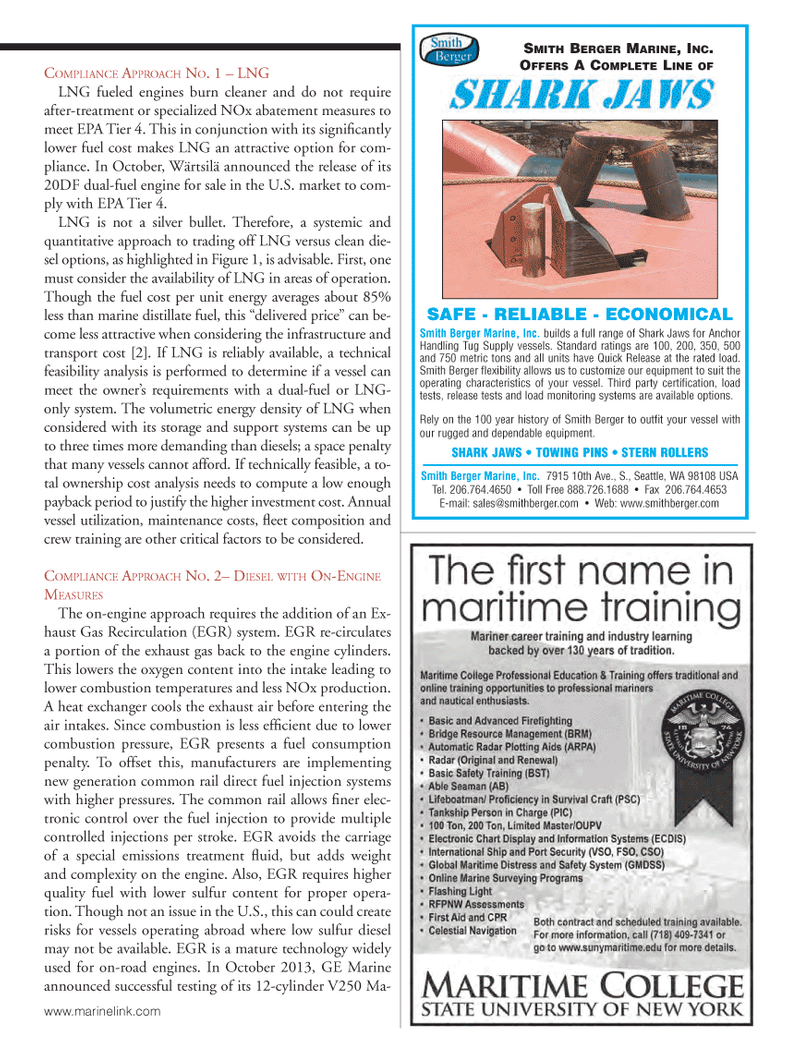
Page 43: of Marine News Magazine (November 2013)
Fleet Optimization Roundtable
Read this page in Pdf, Flash or Html5 edition of November 2013 Marine News Magazine
COMPLIANCE APPROACH NO. 1 ? LNG LNG fueled engines burn cleaner and do not require after-treatment or specialized NOx abatement measures to meet EPA Tier 4. This in conjunction with its signi cantly lower fuel cost makes LNG an attractive option for com- pliance. In October, Wärtsilä announced the release of its 20DF dual-fuel engine for sale in the U.S. market to com- ply with EPA Tier 4. LNG is not a silver bullet. Therefore, a systemic and quantitative approach to trading off LNG versus clean die- sel options, as highlighted in Figure 1, is advisable. First, one must consider the availability of LNG in areas of operation. Though the fuel cost per unit energy averages about 85% less than marine distillate fuel, this ?delivered price? can be- come less attractive when considering the infrastructure and transport cost [2]. If LNG is reliably available, a technical feasibility analysis is performed to determine if a vessel can meet the owner?s requirements with a dual-fuel or LNG- only system. The volumetric energy density of LNG when considered with its storage and support systems can be up to three times more demanding than diesels; a space penalty that many vessels cannot afford. If technically feasible, a to- tal ownership cost analysis needs to compute a low enough payback period to justify the higher investment cost. Annual vessel utilization, maintenance costs, eet composition and crew training are other critical factors to be considered. COMPLIANCE APPROACH NO. 2? DIESEL WITH ON-ENGINE MEASURESThe on-engine approach requires the addition of an Ex- haust Gas Recirculation (EGR) system. EGR re-circulates a portion of the exhaust gas back to the engine cylinders. This lowers the oxygen content into the intake leading to lower combustion temperatures and less NOx production. A heat exchanger cools the exhaust air before entering the air intakes. Since combustion is less ef cient due to lower combustion pressure, EGR presents a fuel consumption penalty. To offset this, manufacturers are implementing new generation common rail direct fuel injection systems with higher pressures. The common rail allows ner elec- tronic control over the fuel injection to provide multiple controlled injections per stroke. EGR avoids the carriage of a special emissions treatment uid, but adds weight and complexity on the engine. Also, EGR requires higher quality fuel with lower sulfur content for proper opera- tion. Though not an issue in the U.S., this can could create risks for vessels operating abroad where low sulfur diesel may not be available. EGR is a mature technology widely used for on-road engines. In October 2013, GE Marine announced successful testing of its 12-cylinder V250 Ma- Smith Berger Marine, Inc.builds a full range of Shark Jaws for AnchorHandling Tug Supply vessels. Standard ratings are 100, 200, 350, 500 and 750 metric tons and all units have Quick Release at the rated load.Smith Berger flexibility allows us to customize our equipment to suit theoperating characteristics of your vessel. Third party certification, loadtests, release tests and load monitoring systems are available options. Rely on the 100 year history of Smith Berger to outfit your vessel with our rugged and dependable equipment.SMITHBERGERMARINE, INC.OFFERSA COMPLETELINEOF SHARK JAWS ? TOWING PINS ? STERN ROLLERS Smith Berger Marine, Inc.7915 10th Ave., S., Seattle, WA 98108 USA Tel. 206.764.4650 ? Toll Free 888.726.1688 ? Fax 206.764.4653 E-mail: [email protected] ? Web: www.smithberger.com SAFE - RELIABLE - ECONOMICALwww.marinelink.com MN November2013 Layout 32-49.indd 43MN November2013 Layout 32-49.indd 4310/28/2013 3:20:39 PM10/28/2013 3:20:39 PM

 42
42

 44
44
